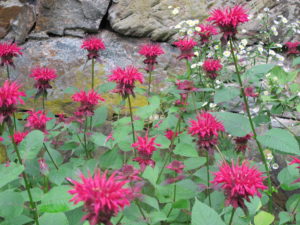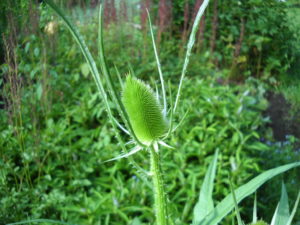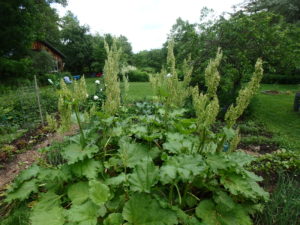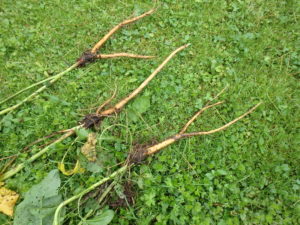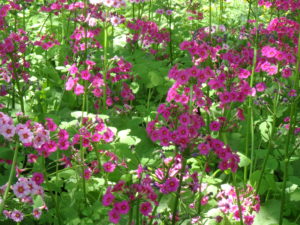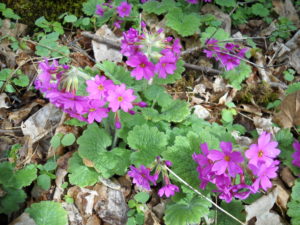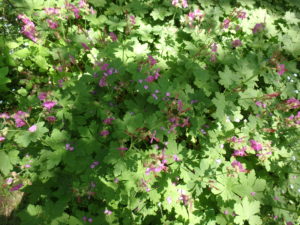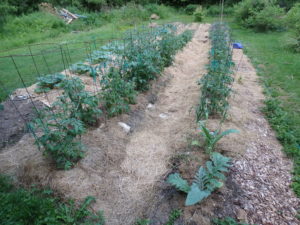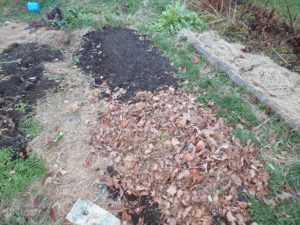When Good Flowers Get Out of Control
Every garden has a few thugs. Nice flowers with handsome blooms that somehow get too rambunctious and take over. They can choke out other plants as easily as weeds. That happens, in part, because we are reluctant to pull them. In general, they have roots that extend and send up new shoots. Let’s look at a few.
I recently pulled up a lot of beebalm (Monarda didyma). That was tough for me to do because it is such a great flower, and it has not yet bloomed. But it had run roughshod over most of one large flower bed, and it had to be brought under control.
Beebalm likes morning sunshine and soil that does not dry out completely. There is also a native beebalm (Monarda fistulosa) that I’ve seen wild in the Mid-west and Rockies. It is shorter, and has pale lavender colored flowers. It does well in hot, dry locations. Our garden beebalm comes in six or more colors from purple to pink – but it does best out of the hot afternoon sun. It sends roots up to a couple of feet, and because it is tall, it can shade-out and out-compete other flowers. As the Red Queen in Alice in Wonderland pronounce, “Off with her head!”
For removing any plant with extended roots, I like the CobraHead weeder. It is curved like a single steel finger, and can be used to loosen the soil under and around weed (or thug-like flower) roots. I gently tug on the flower stem, while loosening the roots. Beebalm, like most plants with long roots, has nodules in the roots. If you break the root, new plant stems will grow from a nodule.
Another difficult plant is Obedient Plant (Physostegia virginiana). What a funny name for a plant that is not the slightest bit obedient. Its roots are problematic because they break so easily, more so than any other plant I know. They send down a tap root that breaks off, even if you have loosened the soil. And it can take over a garden in just a season! I no longer allow it in any of my garden beds, but have moved some to the edge of the woods where deep shade on one side, and lawn on the other, can control it.
All that said, Obedient Plant is a lovely cut flower. It has strong square stems (like mints), and for me it grows up to 5 or 6 feet tall. It lasts well in a vase, with pink or white spikes of many small flowers. I had it in full sun in rich, moist soil, and it ran like crazy!
There is a form of Obedient Plant that has green and white leaves, and it is much more obedient! Like any variegated-leafed plant, this one has less vigor because it has less green chlorophyll to make the food that feeds the roots and flowers. I grow this one, though I find I often need to stake it to keep the flower stems from flopping over.
Another potential thug that I allow in my garden is common teasel (Dipsacus fullonum). Hated by corn farmers in the Mid-West as an invasive weed, it spreads by seed, not root. It’s a biennial. The first year of its life it does not flower, but produces distinctive long, light-green leaves (often with little wart-like bumps) in a low rosette. The second year it sends up a flower stalk up to 6 or 7 feet tall, and produces a seed head that is like a piece of sculpture.
Individual teasel flowers are very small and a light purple, but they don’t all appear at once. Bees love them! The seed head is very showy, a 2-inch spiny extravaganza that looks great in a vase as a cut flower, or later as a dried flower. I wear leather gloves to pick it, and then rub off the spines on the stems for use in vases.
The key to controlling teasel is to learn to recognize and pull the first year plants. That, and picking the stems with flowers before they distribute seeds. I suppose I will get e-mail telling me how stupid I am for allowing this thug in my garden, but I have been able to keep it under control – and I introduced it 20 years ago! Don’t introduce it to your garden unless you can pay attention to it, and keep it controlled.
Sometimes we make mistakes. We see a well-controlled plant blooming in its pot and buy one (or more). We put it in the garden, and only later decide that it has some bad qualities. It has taken me a long time to realize that it’s great to recognize that a plant is not for me, and then be able to dig it up and toss it into the compost.
I recently needed space for a new plant, and decided that I did not like my Siberian Bugloss (Brunnera siberica). I bought it because I have another species of Bugloss (B. macrophylla) that I like a lot. ‘Jack Frost’ Brunnera has lovely small blue flowers in spring and low green and white leaves all summer. But the Siberian relative does not stay in a compact mound, and is a bit floppy. So I yanked it in favor of something new.
Call me fickle if you wish, but I have a limited amount of garden space, and I reserve the right to remove any plant that does not, at least occasionally, cause me to say with glee, “I love that plant!”
Read Henry’s twice-weekly blog posts at https://dailyuv.com/
5 Things You MUST DO in the Vegetable Garden This Weekend – or Soon
Okay, nobody likes to be told what they have to do. Or when they have to do it, so I apologize for telling you what to do. And you don’t really have to do these things immediately, but doing them soon will help you later on.
- It’s time to thin root crops- my least favorite task in the garden. But by now carrots, beets, parsnips and so forth need to be thinned in order for them to develop well.
- You need to put in your tomato supports to keep the plants off the ground, either tying them to stakes or surrounding them with wire cages.
- You need to hill up your potatoes if they have six to twelve inches of green growth by now.
- Cut off those tall flower spikes from your rhubarb. Quick, easy, productive.
- Weed.
Let’s take a look at each of these tasks. First, it’s important to thin root crops that are too close. I’m assuming you planted these frost hardy plants in late April or May, and they have gotten to be 3 inches or so tall by now. They’re big enough that you don’t have to wear your reading glasses to distinguish individual plants.
Carrots and beets can compete with each other just as they would have to compete with weeds. Nutrients from the soil, water, even sunshine is minimized if veggies are too close. So thin your carrots and beets to an inch apart now, and 2 to 3 inches in a month. Yes, you can get a crop without thinning, but the production is vastly reduced. And you can eat the thinnings.
Beets seeds are actually seed capsules with 2 to 3 seeds inside each one. So no matter how well you space your seeds, you will need to thin them. There are monogerm beets like ‘Moneta’ from Johnny’s Selected Seeds that only have one beet embryo per seed capsule, but those are rare. You can re-plant the thinnings, but it’s not always successful. Take a pencil, poke a hole, drop in the roots of the beet, and firm up the soil. Or you can just eat the beet greens.
When I was young and very busy raising kids, I didn’t stake up all my tomatoes. Some I let flop over and lay on piles of straw. Those on the ground suffered from diseases much more than those I caged. I now use 4-legged cages that are 54 inches tall – the biggest commercially available.
This year a friend gave me a home-made cage made from sheep fencing. The fencing is made into a 24-inch cylinder that stands 48 inches tall. Each cage needs a 6-foot grade stake to keep it from tipping over and openings that are big enough for your hand to pass through to pick tomatoes. I’ll decide if this cage is worth replicating next year.
Depending on the weather and where you garden, it may be time to hill your potatoes. This means adding soil over the planted seed potatoes. Roots go down from the seed potato, and new potatoes form above the seed potatoes. If you want lots of potatoes, there has to be room for them to grow. So adding soil from the walkways or your compost pile is essential to having enough depth for good production. Another way to do that is to pile on a thick layer of hay or straw, a technique I am trying with some of my potatoes.
Rhubarb, I have heard, is one of the last flavors to be lost by the elderly as their senses diminish. That’s why, I suppose, that homes for the elderly serve rhubarb desserts at this time of the year. It’s very easy to grow- once established there is little to do other than occasionally add some compost to the soil, or to scratch in some organic fertilizer.
By now, however, rhubarb is sending up tall shoots with white flowers to produce seeds. They are quite spectacular as flowers go – they grow as fast as Jack’s proverbial beanstalks. But like all seeds, they consume energy and minerals from the soil, so it makes sense to cut them down.
Last, but not least, you need to weed. You know that. I find that if weeding becomes a regular part of you day – like brushing your teeth or making your bed – the weeds will not overcome your garden. Even 10 or 15 minutes a day will make a huge difference.
Right now I have been concentrating on tall, deep-rooted weeds like dandelions and burdock. I find that since the soil is moist down deep, it is easier to get these weeds more easily than later in the summer when the soil is dry. I use a garden fork to loosen the soil down a foot or more, then apply even, gentle pressure pulling on the top of the plant. Most come out all in one piece. That’s good, as a broken tap root will send a new plant up later.
Never let weeds go to flower or set seeds. If nothing else, snip or pull off the flowers to keep the weeds from producing seeds. If you have particularly virulent weeds like goutweed, dispose of the flower heads in the trash going to the incinerator or land fill. Some weeds can produce viable seeds even after being pulled or having their flowers cut off.
So get busy in your vegetable garden. There’s lots to do.
Read Henry’s twice weekly blog at https://dailyuv.com/
Primroses and Other Great Plants for Shade
If I were to be consigned to life on a remote island, what one flower would I bring along with me? That’s a bit like asking you which child is your favorite, or which piece of music you could listen to for all eternity.
There are so many wonderful flowers, but some years ago I pondered the question and selected the peony ‘Festiva Maxima’. That’s a double white one with a spot of red in the middle, and a fragrance so alluring, I wrote, that it could make one swoon. I acknowledged that Festiva Maxima does have a flaw: rain weighs down the blossoms, and sometimes the flowers break their stems – even if in a peony support cage.
But if you were to ask me today, I would say my favorite flower is the Candelabra or Japanese primrose, Primula japonica. I have a patch of them blooming in the shade of 3 old wild apples in moist, dark soil. I started with just a few plants, but they drop seeds and fill in spaces, overtaking what was once a meager, struggling lawn.
I estimate that right now I have 200 to 250 square feet of primroses in full bloom; in a 3 foot by 3 foot square, I counted about 25 or 30 plants in bloom – so I have more than 500, perhaps even 750. All this in 10 or 15 years, and no work other than a once-a-year weeding of Jewel Weed, which also loves the conditions.
Each plant has a rosette of light green leaves and sends up a flower stalk 12 to 36 inches tall. Flowers ring the stalk in tiers, starting with one tier, and working up to 4 tiers of blossoms on the oldest plants as the season progresses. At each tier there are a dozen small blossoms – or up to 20 – pointing out like bugles. Each blossoms is about an inch across.
The colors vary as they hybridize. My favorites are a deep magenta. At the other end of the spectrum are the whites, though not pure white. Then there are pink, and dark pink ones. All are fabulous. Fragrance? Nothing much. But that would be like expecting a prize poodle to be able to read the newspaper.
The bloom period starts for me in late May and goes through most of June. A month or more with some blossoms. At any given moment a plant might have just one ring of flowers, or up to 3. As the flowers fade and die off, some develop a nice light blue.
Before the candelabra primroses bloomed came another nice one, albeit with no common name, Primula kisoana. This one, unlike the other, will grow in either moist or dry shade. It has lovely pink blossoms that pop up just 6 inches above the fuzzy leaves that are so dense that they keep weeds from appearing. The leaves are 5 inches or so wide with a scalloped edge and a light green color.
One of the greatest things about the Primula kisoana is that it spreads by root. But unlike mint or bee balm, this little beauty does not run over and outcompete other plants. It will politely meet up with the roots of another, and move to the left or right instead of grasping for every inch of soil. Where I have it in dry shade it gets some morning sun, but no afternoon sun.
Another nice plant I have blooming now, and which can act as a ground cover, is bigroot geranium (Geranium macrorrhizum). To avoid confusion I should explain that the bright red or white geraniums popular in window boxes are not geraniums at all, but are in a genus (scientific grouping) known as Pelargonium. Geranium is a genus of hardy perennials.
The bigroot geranium thrives where other perennials may survive, but few love: dry shade with competition from tree roots. Maples and locust are notorious for sucking everything out of the soil, yet I have planted the bigroot geranium under those trees, and had them thrive. Will they grow under hemlocks or pines? No, that’s asking too much.
Bigroot geranium comes in at least three colors: white, pink and dark pink. The leaves are about a foot tall, with the flower stems standing above them at about 20 inches. Their leaves form a dense mass of foliage that most weeds find inhospitable.
On another note, many readers have been complaining that their tomatoes are yellow-leafed and miserable looking. Not to worry. Tomatoes need sunshine, and early June was, for most of us, rainy and cold. They will recover soon.
Plants suck up moisture that contains the minerals they need – but only if the moisture is required to replace water that the plants have given off. They don’t give off much water vapor when it’s chilly and wet, so they can get nitrogen-starved. With heat and sunshine they will recover.
I have set up Adirondack chairs near my primroses and spend at least some time there every day. And even though I’ll never have to pick just one flower to grow, these primroses are a real delight to me.
Read Henry’s twice weekly blog at https://dailyuv.com/
Mulching: Hay, Straw and More
If weeds are the bane of the gardener, mulch is the gardener’s friend. Not only that, mulch can hold in moisture in dry times, and give a nice, tidy look to the garden.
Let’s start in the vegetable garden. Properly mulched, weeding can be minimal – say an hour a week for a big garden like mine. I keep down weeds in my walkways and around all large plants like tomatoes with a one-two punch: a layer of newspapers (4 to 6 pages thick) and a layer of straw or mulch hay (4 to 6 inches thick before it packs down).
What is the difference between mulch hay and straw? Price, for starters. You can easily pay $8 to $10 a bale for straw, and as little as $2 or $3 for hay. Why is that? Straw is grown as a crop specifically sold as mulch, and it has no seeds. You might see what appear to be seed heads, but they are empty as the farmer grows rye, then cuts it before pollination takes place.
Hay is a waste product: food for dairy cows that got rained on, and is no longer edible. Picky eaters, those dairy cows. And it has plenty of seeds. The newspapers I put beneath it generally keep hay seeds from growing in the garden. But some seeds will escape and grow – particularly in the spring of year two unless you did a phenomenal job of cleaning up in the fall.
Many gardeners use black landscape fabric in the flower garden, covered with bark mulch or wood chips. The fabric is a good barrier, though the roots of some weeds and grasses can get through it, making it difficult to remove. Other gardeners use bark mulch directly on the soil, and that can be effective, too.
If you use wood chips or bark mulch, be sure not to place too thick a layer down. Two to three inches is good, 4 to 6 inches is bad – the mulch will keep a quick rain shower from getting moisture to the roots of your plants.
Some gardeners worry about bark mulch stealing nitrogen from the soil as it breaks down. Don’t. Yes, the microorganisms that break down the mulch need some nitrogen, but I have never seen plant leaves turn yellow (the sign of nitrogen deficiency) because of mulch. Or if you must worry, just put a layer of slow-release organic fertilizer on the soil beneath the mulch.
You can buy wood chips or ground bark mulch in bags or by the truckload. Buying it by the bag is convenient if you just need a little, but it is much more expensive that way.
If buying wood chips by the bag, read the label. If it says, ‘color enhanced’, I would avoid it. It means the chips have been dyed – and I am an organic gardener who does not want chemicals. I have heard that some cheap wood chips are actually construction waste that has been chipped and dyed – old 2-by-4’s and the like.
I like ground hemlock because of the color, and the fact that it tends to last longer than some others (except cedar, but I have only found that for sale in bags). I buy the hemlock by the pick-up truck load.
And please, for the health of your trees, do not create “mulch volcanos.” To keep down weeds some gardeners pile wood chips right up against the trunks of trees in a volcano shape. The wood chips may harbor fungi and bacteria that can attack the bark of your precious tree, eventually killing it in 6 to 10 years. Instead of a volcano, create a “donut.” Leave 3 or 4 inches of space between the tree and the mulch.
My favorite mulch? Fall leaves that have been run over by a lawn mower, then raked and stored for the spring. Full of goodness for the soil, and a good deterrent to weeds. Over the years, leaves will enrich your soil considerably. And they’re free!
Cocoa mulch is sold as a mulch, and I know some who love it. It has a very fine texture and looks nice. But it smells like chocolate chip cookies when it first goes down, and some dogs have been known to consume it – causing sickness and even death if one believes everything one reads on the internet. Chocolate products are bad for dogs. It also tends to mold, though that only lasts a week or so. It can be very slippery when wet; I advise against using it on a hillside.
Buckwheat hulls are an alternative to cocoa mulch, but they are not sold in many garden centers. Like cocoa hulls, they are very fine textured and look very nice, but are very expensive compared to bark or wood chips.
At the Chelsea Flower Show, which I attended recently in London, someone had quotes about gardening stenciled onto blank walls. One of my favorites was from Robert M. Pyle: “But make no mistake: the weeds will win. Nature bats last.” So mulch, but don’t expect to get a summer of weed-free gardening.
Read Henry’s blog at https://dailyuv.com/



